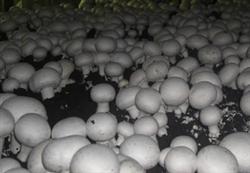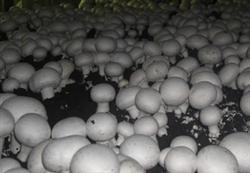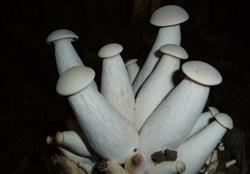Interplanting technique of Cucumber and Pleurotus ostreatus in greenhouse

The greenhouse standard required by this technology: the greenhouse is about 60 meters long and 7 meters wide. It should be built in a place with fertile soil, convenient irrigation and drainage and no pollution. After the shed is built, it is re-applied with organic barnyard manure and potassium and phosphate fertilizer, deeply flattened, and watered again. Then use 0.5% dichlorvos to evenly spray every corner of the shed, and then fumigate with 6 kg of sulfur for 3 days to completely kill the miscellaneous bacteria and pests in the shed. Cultivation and management of cucumber Xintaimi thorn was selected as cucumber variety. After the first true leaf of cucumber seedlings grew in the seedling bed in early October, the pumpkin seedlings with flat cotyledons were grafted and transplanted to the cucumber border which was 1.2 meters wide and watered. Two rows were planted in each border, with a row spacing of 40 cm and a plant spacing of 25 cm. After survival, they were set up and managed normally. Cultivation techniques of Pleurotus ostreatus: first, the production of culture materials. The culture material fermentation was carried out at the beginning of October. Materials are prepared according to the proportion of 1500 kg of wheat straw, 2000 kg of wet cow dung, 500kg of chicken manure, 20kg of urea, 50kg of calcium superphosphate, 50kg of lime and gypsum powder. Then mix and ferment for 25 days, during which the pile needs to be turned 4 times. The excellent fermented material is brown and fragrant, with a pH value of 7.5 and a water content of 65%. Second, the entry of culture materials into the shed and sowing. At the end of October, the fermentation material was put into the shed, and before that, the fermented material was sprayed with an appropriate amount of enemy kill, 400 times of carbendazim and stuffed for 24 hours. When entering the shed, cover the material at 20 cm on each side of each row of cucumbers and show a wavy shape. Practice has proved that this method has high yield and good mushroom quality. After entering the shed, sow seeds according to the proportion of 1 bottle per square meter, and gently press the material surface. Third, cover the soil. About 20 days after sowing, the hyphae ate 2 / 3 of the food to cover the soil. Flood the reserved irrigation ditch before covering the soil. The next day, dig 7 centimeters deep, and cover the soil evenly on the wavy surface, about 3.5 centimeters thick. Fourth, mushroom. About 40 days after sowing (mid-December), it began to bud and produce mushrooms. At this time, the cucumber vine grows to more than 1 meter, creating a good shading environment for Pleurotus ostreatus. In management, it is necessary to spray water in time and correctly grasp the amount of water sprayed. Spray mushroom water for 3 days when budding, when the temperature is lower in the morning and evening, the amount of water sprayed each time is 400,700ml / m2. Spray quality water after stopping water for 2 days, the method is the same as above. Pleurotus ostreatus and cucumber can be listed at the same time before New Year's Day, when the temperature is low, it is the off-season of vegetables, try to prolong the time of mushroom production, so that the mycelium fully rest and recuperate, in order to increase the total yield. Integrated management 1. Strictly control the temperature in the shed. During mushroom production, the temperature in the greenhouse should be controlled at 20 ℃ ~ 30 ℃ in the daytime and more than 10 ℃ at night. When the daylighting is not enough in cloudy days, when the shed temperature is low, it is necessary to appropriately use electric lamps to increase the lighting and temperature at night, and install a 100-watt bulb every 6 meters. As the cultivation of Pleurotus ostreatus on the ground is mainly affected by the ground temperature, the yield of Pleurotus ostreatus will not be affected as long as the temperature in the greenhouse is not too high or too low. Second, correctly grasp humidity and moisture. The humidity in the shed should generally be kept at 60%-80%. After watering or spraying, if the outside temperature is higher, it can be properly ventilated. When intercropping, the hyphae of Pleurotus ostreatus can absorb underground water, and the amount of water sprayed should be 1 / 3 less than that of ordinary mushroom houses, as long as the soil is wet. Third, rational fertilization. Cucumbers should be watered with micro-fertilizer on a regular basis. After the three-tide mushroom, the cucumber leaf surface and the bed surface of Pleurotus ostreatus can be sprayed with 0.2% potassium dihydrogen phosphate and 0.5% urea solution. Fourth, prevent diseases and insect pests. . Brown rot: (1) the route of transmission: covering soil is the main source of transmission, and it can also be transmitted through tools, mushroom flies or human activities. (2) Prevention and control measures: when taking soil, we should choose a place far away from the hole and avoid taking soil from the land where Pleurotus ostreatus compost was used. Cover the soil with 40% formaldehyde or spray 500 times carbendazim on the cover. Stop spraying water on diseased mushrooms and increase ventilation to lower the temperature in the cave to below 15 ℃. The ward can be disinfected by spraying 40% formaldehyde or 500 times carbendazim. Brown spot: (1) the route of transmission: the pathogen enters the cave mainly through covering soil, which is mainly transmitted by splashing water, and can also be transmitted by mushroom flies, mites and human activities. (2) Prevention and control measures: strictly take soil from places where there are no bacteria, do a good job of disinfection, strengthen ventilation and ventilation in the cave, reduce the humidity in the hole, and prevent mushroom flies and mites from entering the cave. When the local disease occurs, formalin can be used for prevention and treatment. Bacterial mites: the cave is fumigated with formaldehyde and dichlorvos. Formaldehyde 3-4ml or dichlorvos 1-2ml was used per m3. After the fungus mites are found on the mushroom bed, 500 times dichlorvos can be sprayed.
- Prev

Interplanting cucumber and Pleurotus ostreatus in warm winter greenhouse
In order to increase the income of the greenhouse, we made use of the warm and humid conditions and limited space in the greenhouse to carry out the three-dimensional planting experiment of vegetables and Pleurotus ostreatus. From October 1996 to May 1997, we planted 200 square meters of Pleurotus ostreatus and produced 2080 kg of Pleurotus ostreatus in a greenhouse of 420 square meters without affecting vegetable cultivation.
- Next

Cultivation of Coprinus comatus with biogas residue
1. Base material formula: 300 kg of biogas dregs, 200 kg of corncob, 10 kg of calcium superphosphate, 1.5 kg of urea, 20 kg of lime powder, 5 kg of gypsum powder, 5 bags of mushroom disease, 240 grams of three-dimensional nutritional essence of edible fungi. 2. base material fermentation: in addition to three-dimensional essence, mix corncob directly with fresh biogas dregs and excipients.
Related
- Fuxing push coffee new agricultural production and marketing class: lack of small-scale processing plants
- Jujube rice field leisure farm deep ploughing Yilan for five years to create a space for organic food and play
- Nongyu Farm-A trial of organic papaya for brave women with advanced technology
- Four points for attention in the prevention and control of diseases and insect pests of edible fungi
- How to add nutrient solution to Edible Fungi
- Is there any good way to control edible fungus mites?
- Open Inoculation Technology of Edible Fungi
- Is there any clever way to use fertilizer for edible fungus in winter?
- What agents are used to kill the pathogens of edible fungi in the mushroom shed?
- Rapid drying of Edible Fungi

